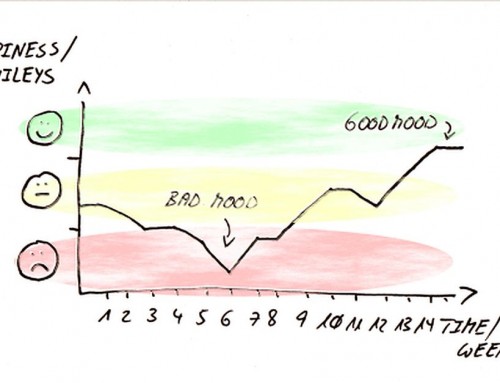Show With Minimal Effort Your Respect, Commitment, Engagement, And Concerns
Mad, Sad, Glad, Afraid
Summer 2017. At the site of my client. I facilitate a workshop for the upper management of my client's software development department. Topics were agile principles, cross-functional collaboration, commitment, and feature teams.
Starting with a warm-up exercise, I introduce the participants to a new, challenging communication structure to welcome themselves right at the beginning. The managers got the idea immediately and were eager to step in this new experiment. Each of them flags – within her individual limits – her personal engagement and commitment to the 1-day workshop.
Frank, head of the dev.department, started:
„I'm checking in. — I'm glad, everyone followed the invitation and joins us today. — I'm glad we will talk about new ways to collaborate better in the future. — I'm mad about the silo thinking of our own project teams. — I'm sad about we couldn't stop this earlier. — I'm afraid, I have to leave earlier this afternoon.
I'm in.”
Then Vitaly jumped in:
„I'm checking in. — I'm glad, that I could make it happen to be here. On my way to the venue this morning, there was a huge traffic jam. — I'm glad we start to renovate ourselves. — There is nothing, I'm mad or sad about. — I'm afraid, we won't touch the topics extensively enough today, and therefore we need to have more workshop sessions. — I'm afraid, this may take ages.
I'm in.”
Arthur, Petra, Monica, John, Alex, Yan, and Chen continued in this pattern.
Suddenly, after two hours workshop, Monica's attention is grabbed by her mobile phone. An urgent call by an important customer. Monica stands up and exits the room by saying "I'm out". — Some minutes later, she comes back, says "I'm in" and sits down.
Do you get the idea? – Check-in, Check-out!
You use certain linguistic triggers and distinct communication patterns to run meetings and workshops more effective and with deeper structure. Make your collaborations stickier. Communicate your intentions and expectations clearer.
- "I'm checking in" – signals everyone your readiness to contribute to the common goal.
- "I'm glad <that>" – signals everyone that you are in a positive attitude because something will take place – not necessarily correlated to the common goal.
- "I'm sad <that>" – signals everyone that you are frustrated about something happened – not necessarily correlated to the common goal.
- "I'm mad <that>" – signals everyone that you are angry about something – not necessarily correlated to the common goal.
- "I'm afraid <that>" – signals everyone that you are worried about something happened – not necessarily correlated to the common goal.
- "I'm in" – signals everyone that you are committed to contributing despite any triggered deviations, or distractions.
- "I'm out" – signals everyone that you do not contribute for a while or even any longer to the common goal. You always can come back with "I'm in".
Most important: never, ever question "Why are you mad, ...sad, ...glad, ...afraid about <x>?". No discussion at the one side, no excuses and becauses at the other side. Just take the information as given and granted only.
Due to its formalism, this communication style looks at the first glance weird and stiffy. However, there are 3 benefits in this technique:
- you show your teammates and colleagues your respect: namely being engaged and being committed.
- you are honest with yourself and others without insulting them. If either you can't contribute anything (more), or the session has no (more) value for you, you have the autonomy to Check-out. – And this holds for everyone!
- with this stencil, you are able to communicate personal emotions easier: "I'm mad, ...sad, ...glad, ...afraid". – Usually, it's very tricky to show emotions in the professional business environment. Using this patterns, emotions are covered by the linguistic formalism.
Here is my challenge for you:
Start your personal experiment tomorrow! – Try these schemes at your next meeting, workshop and cooperation with your colleagues.
And please share your experiences in the comment area of this post.
P.S.:
- By the way, the Check-in, Check-out patterns, and the Mad, Sad, Glad, Afraid triggers are part of the so-called Core Protocols created by Jim and Michele McCarthy. The Core Protocols are best practices, i.e., a set of commitments and procedures, to form effective and high-performance teams.
- Mad, Sad, Glad, Afraid found its way as facilitation technique into agile retrospectives as well.
- The Check-out pattern – the autonomy to leave – has its correlates in the "bumblebees" and "Law of two feets" of Open Space Technology (OST).
- Judy Rees published with Clean Language a related approach to communicate more effectively with simple linguistic patterns.







Leave A Comment